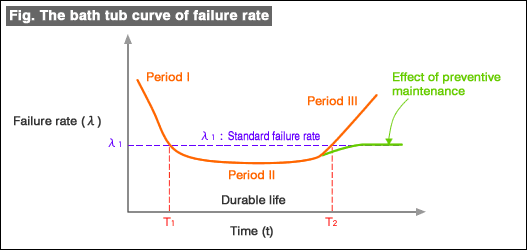#060 Periods of Mold Failures
Machines and manufacturing facilities that contain molds may have their functions stopped or seriously curtailed due to "failure".
It is known that failures can be classified statistically into three classes depending on the period of their occurrence.
Failures are of the following three types.
|
I.Initial failure period (initial failure)
This is the period in which failures occur due to quality defects in the components of molds, etc., or due to basic design mistakes. Since such failures occur soon after starting the use of molds, etc., it will not be possible to start continuous production.
II.Random failure period (random failure)
This is the period in which failures occur due to some cause in the middle of stable operations that are being made for some time using molds, etc., for continuous production.
The causes of such failures can be insufficient quality level in the design, which can cause some of the components to exhaust their lives, or due to some component breaking due to the effect of more than expected stress, etc.
Since it is difficult to predict the period of occurrence of failures during this period, this period is being referred to as the random failure period.
III.Wear-out failure period (wear-out failure)
This is the period in which failures occur during continuous production using molds, etc., due to their being used near the expected life in terms of the number of shots.
The cause of such failures is the wearing out of components. The period when wear-out reaches the limit of usability can be predicted using sampling and by experience.
Therefore, it can be said that it is possible to some extent to avoid the occurrence of wear-out failures by preventive maintenance.
The relationship between the failure period and the failure rate plotted as a curve as shown in the figure is called the bath tub curve because the curve of failure rate with respect to the time axis is similar to the cross-sectional shape of a bath tub.




